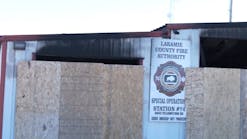Swormville, NY, Fire Co. Awaits Lawsuit Outcome after Nearly Two Decades
By Stephen T. Watson
Source The Buffalo News, N.Y.
The Swormville Fire Company paid its team of lawyers more than $250,000 over eight years while it waited for a lawsuit over the flawed design and construction of its new fire hall to go to trial.
The HoganWillig law firm – now known as Tiveron Law – continued to say the case wasn’t ready for court, even as it kept sending the volunteer fire company more legal bills.
Swormville Fire Company Legal Fight
Swormville Fire Company’s fire hall on Transit Road in Clarence is at the heart of a longstanding legal dispute. The fire company, which claimed there were flaws in the building's design and construction, is now fighting off a lawsuit from the law firm that once represented Swormville and now claims it is still owed fees for this legal work.
Now, two decades after the firefighters first asked for help, they are battling over hundreds of thousands of dollars Tiveron says it is still owed from a lawsuit the law firm walked away from.
The case pits Swormville’s 45 active firefighters against one of the region’s largest law firms – and one unafraid to turn to the courts to pursue payment of outstanding legal fees.
“This whole thing is just so frustrating. I don’t understand it,” Stephen Moeller, a former Swormville president and longtime board member, said in an interview. “It’s like we got in bed with the devil and we can’t get out of it.”
Fire company stresses value to towns
During 2005, Swormville Fire Company volunteers in Amherst devoted more than 23,000 hours to fire and medical calls, drills, training, work details, meetings and supervisory duties. “This is what we do for free,” said John J. Gaulocher, administrative president. “We don’t get paid for any of it.” Tuesday night, officers of the company — one of eight fire districts
Fire company officials say they want to get back to serving their community and see the legal standoff come to an end. They accuse HoganWillig of mishandling the case from the beginning and note that they were able to settle the lawsuit just two years after another firm took over.
But managing partner Diane Tiveron staunchly defended her law firm’s efforts and described its lawsuit against Swormville as a run-of-the-mill legal billing dispute unworthy of media attention.
“We engaged in a great deal of work on behalf of a client who chose not to pay for it, and we proceeded to try to enforce our rights,” she told The Buffalo News.
Building defects cited
Swormville, a volunteer fire company in East Amherst and Clarence, in the early 2000s decided the department needed a new, modern building to replace its aging fire hall on Transit Road.
The fire company hired K2M Architects to design the new facility at 6971 Transit and Picone Construction Corp. of Clarence to build the 17,000-square-foot structure. Work began in spring 2003 and largely wrapped up one year later.
Fire company officials said in court filings they soon noticed problems resulting from its “defective” design and construction.
Moeller said the roof leaked and suffered from ice damming due to heat loss; the firewall that separates the truck bays from other areas wasn’t built up to code; the concrete truck bay floor didn’t cure properly; and the bay door supports weren’t strong enough to hold energy-efficient doors.
Swormville officials turned to Steve Cohen, an attorney and company member, to represent their legal interests. Swormville didn’t have a retainer agreement with Cohen, Moeller said in an affidavit.
Cohen in 2007 filed a complaint against K2M and Picone seeking $1.26 million in damages, plus interest.
The litigation remained active when, two years later, the Lorenzo & Cohen law firm merged with HoganWillig.
Cohen in March 2011 told the Swormville board the case was scheduled to go to trial in January 2012.
By November 2011, however, HoganWillig’s Corey Hogan told board members that his law firm needed a “strategic plan” for the litigation and he had sought a delay because he “did not believe the case was ready for trial,” according to an affidavit from another Swormville official, Michael Belcher.
‘We’re out of here’
The fire company said the lawsuit seemed to pass regularly from one HoganWillig lawyer and paralegal to another, requiring architect Kenneth Pearl, one of several experts retained by Swormville, to bring each new staff person up to speed.
All along, HoganWillig billed the fire company for its services, even though Swormville said there was no retainer agreement and the firm didn’t provide monthly invoices, Belcher and Moeller said.
HoganWillig offered to discount its fees by 50% in recognition of the time spent on the case, according to the fire company, but its invoices lacked specifics showing whether this was happening.
The firm and the fire company reached a retainer agreement in 2012, but Swormville fire officials said they remained frustrated at the case’s pace.
“It was never a priority for them. It was a money churner. They were using it to generate revenue from us,” Moeller said.
The animosity was mutual, according to a 2015 email from a HoganWillig lawyer to a colleague that was quoted in court documents.
Referring to Hogan, the lawyer wrote: “Corey has bent over backwards for them and they don’t appreciate it. They are ungrateful, overcritical complainers.”
This came to a head at a meeting on Aug. 31, 2015, where Swormville board members sought solid answers on their billing and case-status concerns.
Hogan, according to Belcher and Moeller, pushed back, blaming the delays on the fire company and bristling at a question about whether the case was too big for his firm. Asked how close the lawsuit was for trial, Hogan said “40%.”
Finally, according to a meeting recording, Hogan said, “I am not taking this (expletive) from you guys. Who do you think you are abusing us? We’re out of here.”
At that, the HoganWillig team walked out.
One day later, Hogan emailed Swormville’s board that the relationship between the parties had “irretrievably broken down.” He defended his firm’s work in light of the case’s complexity and the need for unassailable expert testimony to support the size of the fire company’s claim: as much as $1.9 million on a building that cost $2.3 million.
Swormville’s costs
Swormville officials turned to Kenney Shelton Liptak Nowak to pick up their claim against Picone, K2M and third-party defendants.
Moeller and attorney D. Charles Roberts Jr. said HoganWillig left the case file a mess and pursued a flawed strategy that didn’t take into account how much insurance the architect and builder carried to cover a settlement.
In all, more than 30 attorneys, paralegals and other HoganWillig staffers billed for their work on the file, said Roberts, the fire company’s latest attorney from the Gross Shuman law firm.
“I think the case did not need to be as complicated as it was for HoganWillig,” he said. “It just required a cogent strategy from the beginning and then act on that strategy.”
Less than two years later, in 2017, lawyers with Kenney Shelton settled the litigation with Picone, K2M and various subcontractors for $1.3 million.
Anthony Picone, president of the family-owned Picone Construction, said his firm followed the architect’s designs to the letter and the fire company didn’t raise any concerns until well after the fact.
He said the court fight cost Picone $300,000 in legal fees and $400,000 toward the settlement but the company still stands behind its work on the fire hall.
“We didn’t do a thing wrong,” Picone said. “That job was perfect.”
K2M attorney Michael Damia declined comment beyond noting K2M did not admit to wrongdoing in the settlement.
The settlement amount initially was deemed confidential, but HoganWillig revealed the figure in a later court filing.
The fire company had paid $900,000 in litigation costs, including expert and legal fees. HoganWillig had collected $251,577, a figure that included prior payments to Lorenzo & Cohen.
When HoganWillig learned of the settlement, the firm tried to block the fire company from collecting the payout. It argued it was entitled to 20% of the “net recovery,” Roberts said.
When this was ultimately unsuccessful, HoganWillig in 2019 sued the fire company. Roberts said the firm is seeking $332,625 in additional fees.
A State Supreme Court judge ruled HoganWillig gave up any claim to the settlement money when it gave up the case. Tiveron is appealing that decision.
Swormville has filed several counterclaims that accuse HoganWillig of overbilling, “attorney deceit” and other misconduct.
Cohen declined an interview, but said he had removed himself from the billing dispute because of his fire company membership.
“I do not represent my law firm because I perceived it to be, at the very least, awkward,” he said in a text message.
Hogan did not respond to voicemail and email messages seeking comment.
However, in a 2021 statement to the Clarence Bee, Hogan said his firm “took great measures to both manage the costs of litigation and to assure the Swormville Fire Company that HoganWillig was doing everything it could have to bring the matter to a resolution.”
Hogan, stripped of his law license, states his case to the legal community
Corey J. Hogan, in an email to lawyers in the region, vows to challenge the suspension of his law license and defends the actions that led a panel of judges to bar him from practicing law for two years.
The State Supreme Court Appellate Division, Fourth Department, in December 2022 barred Hogan from practicing law for two years because, the judges concluded, he had mixed a client’s business with the finances of HoganWillig. The decision, unrelated to Swormville, required Hogan to sell his HoganWillig ownership stake.
Tiveron took control of the renamed firm. She said the case file changed hands over the years, but HoganWillig adjusted its fee structure to ensure it was fair for the fire company.
HoganWillig provided Swormville the best possible legal representation, she said, and it’s not unusual for this type of commercial litigation to take years to resolve.
“This was a construction case that had a lot of moving parts to it,” Tiveron said.
As for Moeller, he said the nearly $421,000 the fire company received from the settlement, after litigation expenses, didn’t cover the cost to fix the fire hall.
Swormville’s budget comes from its fire-protection contracts with the towns of Amherst and Clarence.
The fire company has had to put off buying updated equipment and scale back training for new firefighters because of its spending on litigation and building repairs, Moeller said.
He added that he and his Swormville colleagues are volunteers who just want to serve their community, and it’s beyond aggravating their court fight continues after so long.
“I’m absolutely disgusted,” he said. “I had faith in the legal process, and I don’t anymore.”
___
(c)2024 The Buffalo News (Buffalo, N.Y.)
Visit The Buffalo News (Buffalo, N.Y.) at www.buffalonews.com
Distributed by Tribune Content Agency, LLC.






